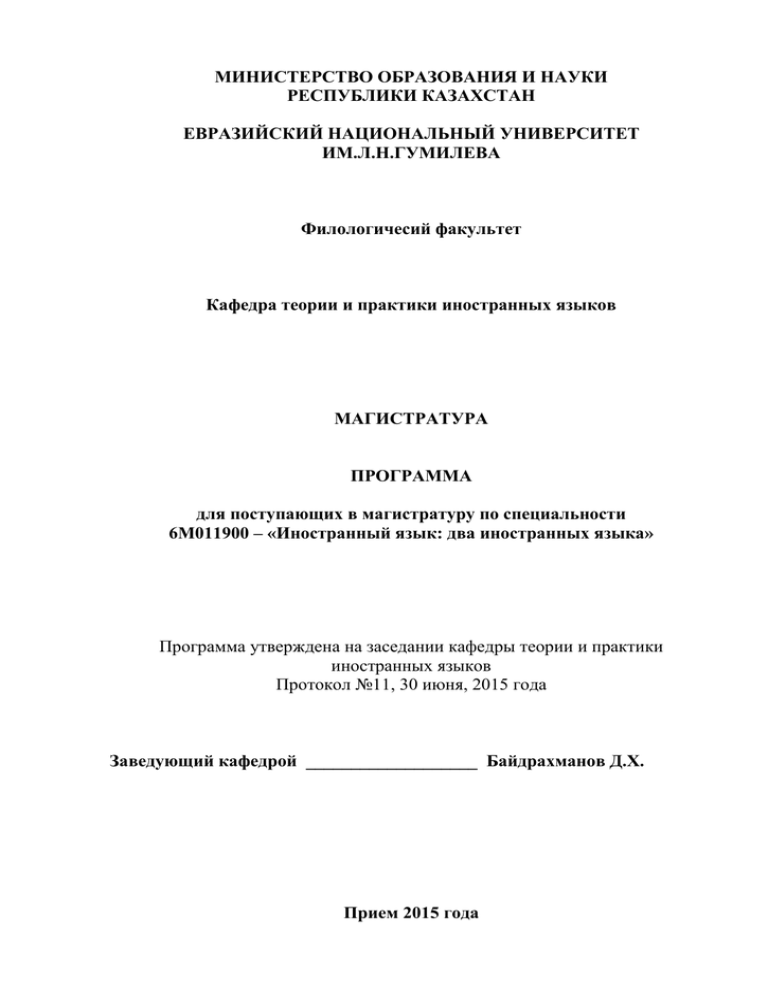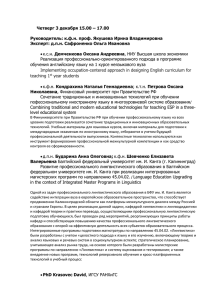Иностранный язык: два иностранных языка
реклама

МИНИСТЕРСТВО ОБРАЗОВАНИЯ И НАУКИ РЕСПУБЛИКИ КАЗАХСТАН ЕВРАЗИЙСКИЙ НАЦИОНАЛЬНЫЙ УНИВЕРСИТЕТ ИМ.Л.Н.ГУМИЛЕВА Филологичесий факультет Кафедра теории и практики иностранных языков МАГИСТРАТУРА ПРОГРАММА для поступающих в магистратуру по специальности 6M011900 – «Иностранный язык: два иностранных языка» Программа утверждена на заседании кафедры теории и практики иностранных языков Протокол №11, 30 июня, 2015 года Заведующий кафедрой ___________________ Байдрахманов Д.Х. Прием 2015 года Программа для поступающих в магистратуру по специальности 6M011900 – «Иностранный язык: два иностранных языка» 1. Grammar as a science. Two parts of grammar: Morphology and Syntax. 2. Say what the term “Method” may mean in Foreign Languages Teaching and Learning. 3. Give definition of the term “Approach” in Foreign Languages Teaching and Learning. Speak about the notions that are attributed to it. 4. The Verb: Semantic, Morphological, Syntactical and Grammatical Categories. 5. Speak on the Direct Method; give the general outline of its principles and procedures. Tell what guidelines for teaching oral language were adopted in Berlitz schools. 6. Describe limitations of the Direct Method according to Henry Sweet. 7. The Noun: Semantic and Morphological, Syntactical properties. 8. Speak on Oral Approach and Situational Language Teaching; give its background and general outline. Describe the role of vocabulary in Oral Approach and Situational Language Teaching. 9. Give the background of the Audiolingual Method. Describe it in terms of Approach, Design, and Procedure. 10. Give the background of the Community Language Learning. Describe it in terms of Approach, Design, and Procedure. 11. What is the similarity between learning a natural language and learning a programming language? 12. Adjectives. 13. Give the background of Total Physical Response. Describe it in terms of Approach, Design, and Procedure. 14. Give the background of Suggestopedia. Describe it in terms of Approach, Design, and Procedure. 15. Lexico-grammatical features of Non-finite forms of the Verb. 16. Give the background of Silent Way. Describe it in terms of Approach, Design, and Procedure. 17. Give the background of Communicative Language Teaching. Describe it in terms of Approach, Design, and Procedure. 18. Speak on Communicative Language Teaching as a learner-centered and experience-based method. 19. Syntax. 20. Speak on the main goal of teaching foreign languages according to the Conception of Foreign Languages Education in the Republic of Kazakhstan. 21. What's the difference between short and long passives? Speak about functional peculiarities of short passives in modern English. 22. Speak on the Kazakhstani methodologists and their contribution to the development of FLTL. 23. Speak on the Concept of Polylingual Education in the Republic of Kazakhst an. 24. Homonymy. 25. Speak on communicative competence and its elements. Describe each in detail and speak on the ways for building it. 26. Types of sentences. 27. Speak on planning as an integral part of teaching profession. Describe the types of plans you know, say how they help organize the teaching process effectively. 28. Speak on technological aspects of FLTL: say what equipment can be applied to the teaching and learning process and how to use it effectively. 29. Composite sentences. 30. Speak on evaluation and assessment in FLTL: role and place, ways and tools. 31. Speak on the Content and Language Integrated Learning. 32. Speak on the types of assessment used in FLTL: formative, summative and final; describe their possible procedures and effect they produce on FLTL. 33. Non-notional parts of speech. 34. Describe the three major reading speeds and how to teach them in foreign language teaching. Say why each of them is important. 35. Stylistic Classification of the English Vocabulary. 36. Speak on intensive and extensive reading in FLTL: their role, place in the teaching and learning process, give example activities. 37. Speak on the three elements of a communicative activity: choice, feedback, and information gap; say how to ensure them in a teaching speaking class. Give examples. 38. General Notion and Peculiarities of the English Phonetics. Speak on different ways of organizing oral-aural interaction in a foreign language classroom. Say if variation plays an important role. 39. Phonetic stylistic devices. 40. Speak on using authentic audio recordings in FLTL: where you can find them, criteria to choose the appropriate piece, how to work with them in the classroom. 41. Speak on receptive language skills to be taught in FLTL: their role and place in the learning process, ways of organizing work for their development. 42. Speak on productive language skills to be taught in FLTL: their role and place in the learning process, ways of organizing work for their development. 43. English Lexicology as a branch of linguistics. 44. Speak on using interactive techniques in FLTL: role play, project, drama, brainstorming, Pecha Kucha, etc. 45. Speak on the Content and Language Integrated Learning. 46. Speak on using modern informative techniques in FLTL: mobile learning, e-learning, blended learning, etc. 47. Characterize the imperative mood. Give examples. 48. Characterize predicative clauses. Give examples. 49. Characterize object clauses. Give examples. 50. Define functional-semantic types of conjunctions. Give examples. Әдебиеттер тізімі: 1. 2. 3. 4. Закон об Образовании РК. Концепция развития образования РК до 2015, Алматы 2004. Концепция гос.стандарта высшего образования РК. Алматы, 1999. Государственная концепция развития системы среднего образования РК. Алматы, 1999. 5. Назарбаев Н.А. Казахстан 2030. Послание Президента РК Н.А.Назарбаева народу Казахстана. 27 января 2012 www.akorda.kz 6. Выступление министра образования и науки РК Б.Т.Жумагулова www.edu.gov.kz. 7. Государственная программа развития и функционирования языков в Республике Казахстан на 2011–2020 годы от 29 июня 2011 года № 110. 8. С.Г. Тер-Минасова, Война и мир языков и культур. М.: АСТ, Астрель. Хранитель, 2007. 9. Осипова Г.А. Полиязычное обучение как фактор эффективности поликультурного образования. 10. Кунанбаева С.С. Теория и практика современного иноязычного образования. Алматы. 2010. 344с. 11. Кунанбаева С.С. Современное иноязычное образование: методология и теория. Алматы. 2005. 264с. 12. Кунанбаева C.C.. Актуальные проблемы профессиональной подготовки личности будущего специалиста. Алматы. 2001 13. Козлов П.Г. Коммуникативные умения как ядро иноязычной коммуникативной способности. Алматы. 2004. 14. Антрушина Г. Б., Афанасьева О. В., Морозова Н. Н. Лексикология английского языка: Учебн. пособие для студентов. - 3-е изд., стереотип. – М.: Дрофа, 2001 15. Platt, J. Weber, H. Ho, M.L. (1984). The New Englishes. London: Routledge. 16. Stefan Neubert, Toward a Constructivist Theory of Discourse, University of Cologne 2002. 17. Курманбаев Н.М. Методика обучения английскому языку в казахской аудитории. Алма-Ата. «Мектеп», 1988 18. Козлов П.Г. Когнитивно-коммуникативное обучение иностранным языкам. Вестник КазУМОиМЯ. 2002. 19. Введение в литературоведение. Учебное пособие. Под ред. Н. А. Чернокозова.: М, 2006, 312 стр 20. Исаев М.К. Introducing contemporary English Linguistics. Учебно-методическое пособие по теории англ.яз. Алматы, 2009. 147с. 21. Гальскова Н.Д. Современная методика обучения иностранным языкам. М.,2003. 22. Закон об образовании Республики Казахстан. // Казахстанская правда. 23. Зимняя И.А. Речевой механизм в схеме порождения речи (применительно к задачам обучения иностранным языкам). //Психологические и психолингвистические проблемы владения и овладения языком. М., «Просвещение», 1969. 24. Зимняя И.А. Психология обучение иностранным языкам в школе. М., «Просвещение», 1991 25. Зимняя И.А. Психология обучения не родному языку. М., «Русский язык», 1989. 26. Зимняя И.А. Педагогическая психология. Ростов-на-Дону, «Феникс», 1997. 27. Иванова А.М. Обучение письменной речи на французском языке. М., «Просвещение», 1981 28. Китайгородская Г.А. Методические основы интенсивного обучения иностранным языкам. М., Изд.МГУ. 1986. 29. Колкер Я.М., Устинова Е.С., Еналиева Т.М. Практическая методика обучения иностранному языку. М., «Academa», 2000 30. Леонтьев А.А. Психология общения. Тарту, 1974 31. Антология педагогической мысли Казахстана. / Составители: К.Б. Жарикбаев, С.К. Калиев/. – Алматы 1995 32. Миньяр-Белоручев Р.К. Методика обучения французскому языку. М., «Просвещение», 1990 33. W.Littlewood. Communicative language teaching. Cambridge language teaching library. 1993. 34. Pete Sharma. Blended learning. Macmillan. 2007 35. Беспалько В.П. Педагогика и прогрессивные технологии обучения. - М.,1995. 36. Finegan Edward. Language: Its Structure and Use. Boston: Thomson Wadsworth, 2007. 37. Yule George. The Study of Language. New York: Cambridge University Press, 2006. 38. В.А.Маслова. Homolingualis в культуре. М.: Гнозис, 2007. 39. Л.Л. Нелюбин. Лингвостилистика современного английского языка. М., 2007г 40. Расторгуева Т.А. История английского языка, ч.1. М., 1969, ч.2. М., 1972. 41. Ильиш Б.А. История английского языка, Л., 1973. 42. Смирницкий А.И. Хрестоматия по истории английского языка, М., 1953. 43. Иванова И.П., Чахоян Л.П. История английского языка. М., 1976. 44. Бруннер К. История английского языка, М., 1955. I-II части. 45. McMannon A., Lexical Phonolgy and the History of English. С.U. Press, 2000. 46. Blake N.F. A history of the English language. Basingtoke: McMillion, 1996. 47. Hughes A. A History of the English words. Oxford University Press, 1996.

